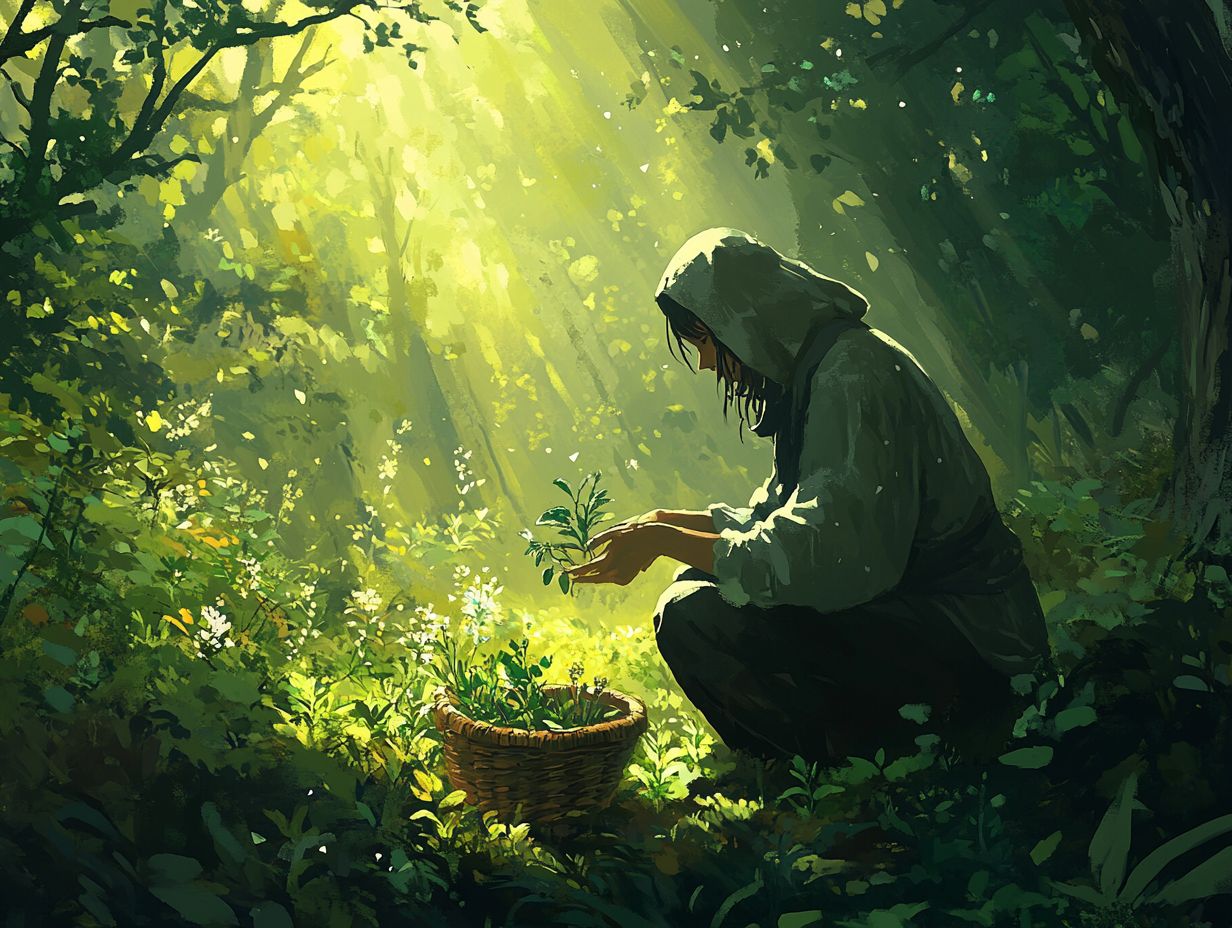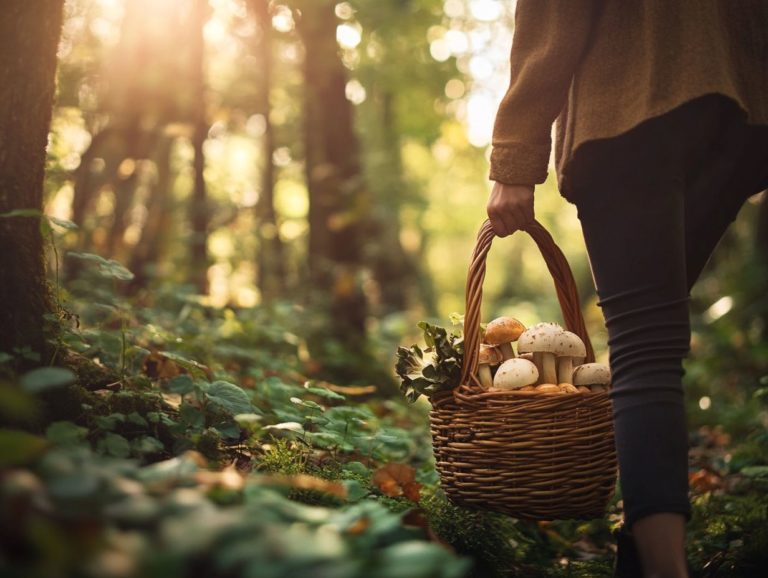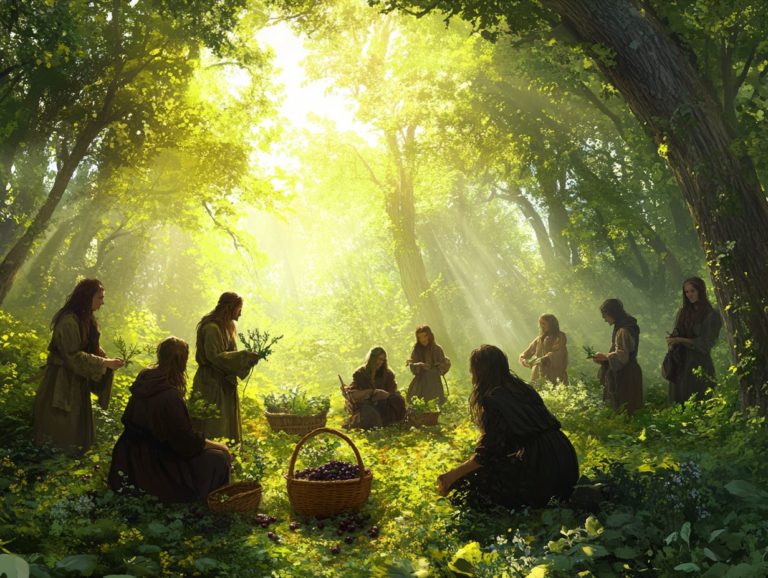7 Ways to Ensure Sustainable Foraging Practices
Foraging is an age-old practice that strongly links you to nature, but it carries significant responsibilities.
As you delve into the rich bounty of your local landscapes, grasping the principles of sustainable foraging is crucial for preserving the environment for future generations. This article outlines seven essential practices that will guide you in foraging responsibly, from understanding local laws to respecting protected species.
By embracing these techniques, you can savor the gifts of nature while minimizing your impact and fostering biodiversity. Explore how your actions can contribute to a more sustainable future through the art of foraging!
Contents
- Key Takeaways:
- 1. Know the Local Laws and Regulations
- 2. Identify and Respect Protected Species
- 3. Only Take What You Need
- 4. Learn How to Properly Harvest and Store Plants
- 5. Avoid Overharvesting from the Same Area
- 6. Leave No Trace and Minimize Your Impact
- 7. Support Sustainable Foraging Organizations and Initiatives
- What Are the Benefits of Sustainable Foraging?
- Why Unsustainable Foraging Threatens Our Environment!
- How Can Foragers Help Preserve Biodiversity?
- What Are Some Sustainable Foraging Techniques?
- What Are Some Common Mistakes Made by Foragers?
- How Can Foragers Educate Others about Sustainable Practices?
- What Are Some Sustainable Alternatives to Foraging?
- Frequently Asked Questions
Key Takeaways:

- Know and follow local laws and regulations to ensure sustainable foraging practices.
- Identify and respect protected species to preserve biodiversity and maintain a healthy ecosystem.
- Only take what you need and learn proper harvesting and storage techniques to avoid overharvesting (taking too much) and wastage.
1. Know the Local Laws and Regulations
Understanding local laws and regulations surrounding foraging is essential for anyone passionate about sustainable foraging practices. Learning how to use local resources for sustainable foraging prioritizes your safety and helps protect local ecosystems while promoting environmental stewardship within your community.
Different regions may impose specific regulations, such as limits on the quantities of wild plants or mushrooms you can collect, designated seasons for foraging, or protected areas where foraging is strictly prohibited. These laws play a crucial role in preventing overharvesting and ensuring that delicate ecosystems thrive, which supports diverse wildlife.
By following these regulations, you contribute to ethical practices that respect local flora and fauna, fostering a harmonious balance between human needs and the health of nature. To learn more about this, check out sustainable foraging best practices. By foraging responsibly, you can make a real difference!
2. Identify and Respect Protected Species
Identifying and respecting protected species is essential for you as a forager. Many plants and fungi are designated for conservation, playing a crucial role in maintaining biodiversity and supporting the well-being of plants and animals in an area.
Understanding which species are protected not only helps you avoid legal penalties but also deepens your appreciation for the intricate web of life that sustains us all. Techniques such as studying field guides, utilizing mobile apps, and engaging with local experts can significantly enhance your skills in plant identification.
Conservation efforts are vital for preserving these species, ensuring that future generations can also reap the benefits of a balanced ecosystem. By collaborating with conservation organizations, you can actively contribute to the protection of endangered plants and fungi, reinforcing the importance of stewardship in your foraging practices.
3. Only Take What You Need
Practicing sustainable foraging means you take only what you need, following guidelines such as those in foraging responsibly: 5 key principles, ensuring that the wild abundance remains intact for future generations and supports the health of local ecosystems.
This mindful approach highlights the significance of reciprocity in nature, where every forager respects the delicate balance of their surroundings. Techniques such as selective harvesting picking only ripe fruits or vegetables perfectly embody this principle. Using tools like pruning shears instead of tearing or uprooting plants minimizes potential harm to the ecosystem.
Implementing methods like rotational harvesting alternating your gathering areas further gives ecosystems the time they need to recover, fostering a sustainable relationship with the wild. By embracing these practices, you not only relish the bounty of nature but also play a vital role in its preservation.
Join the movement for a sustainable future! Every small action counts let s make a difference together!
4. Learn How to Properly Harvest and Store Plants

Learning the right ways to gather plants and storage methods for edible plants is essential for you as a forager. Mastering these skills ensures the quality and safety of the wild foods you collect, including medicinal plants and their various uses.
Understanding different harvesting methods can elevate your foraging experience. Knowing the best times for collecting herbs and fruits is crucial, as certain seasons can enhance their flavor and nutrient density. Use gentle methods, like scissors for delicate plants, to prevent damage and encourage future growth.
Once you’ve gathered your bounty, it’s important to store these plants correctly. Some thrive in cool, dark places, while others benefit from refrigeration or drying.
Follow best practices in timing and storage to preserve the nutritional and medicinal properties of your wild edibles.
5. Avoid Overharvesting from the Same Area
Avoiding overharvesting is crucial for maintaining the health of local flora and minimizing your environmental impact. Utilizing top resources for sustainable foraging supports the sustainability of foraging practices.
By rotating your foraging locations, you give plant populations the time they need to regenerate. This allows ecosystems to flourish and boosts biodiversity, enhancing soil health for various species.
Regular monitoring of plant populations enables you to identify trends and catch declines early. Implementing these strategies helps preserve the delicate balance of nature while promoting responsible harvesting.
This mindful approach lets you connect more deeply with nature and its wonders!
6. Leave No Trace and Minimize Your Impact
Following the leave no trace principles is essential as a forager. This commitment promotes outdoor ethics and minimizes your impact on the environment, ensuring it remains pristine for future generations.
Respecting nature is vital when you forage. Be mindful of your surroundings and identify how to forage responsibly with sustainable harvesting practices that won’t harm local ecosystems. Avoid overharvesting to protect plant populations and the wildlife that relies on them. Remember to tread lightly and avoid trampling delicate flora and fauna.
By being aware of your impact, you can leave areas just as you found them. This way, others can enjoy the joys of foraging while you help maintain the health of the environment.
7. Support Sustainable Foraging Organizations and Initiatives
Supporting sustainable foraging organizations enhances community education and cultivates a culture of environmental stewardship among foragers and nature enthusiasts.
Institutions like U.C. Berkeley and the National Audubon Society play a vital role, providing workshops and resources that educate the public on the ethics and safety of foraging. By engaging with local communities, these organizations foster appreciation for biodiversity and ecosystem balance.
The hands-on experiences they offer enable participants to identify native plants responsibly and understand their critical role in local habitats.
As you learn about sustainable practices, your involvement helps create an environment where responsible foraging transforms from a trend into a cherished tradition. Join a local workshop today to become a more responsible forager!
What Are the Benefits of Sustainable Foraging?

Sustainable foraging offers many benefits. It strengthens community bonds and connects you with nature. It also supports food sovereignty, which means having access to healthy, culturally appropriate food produced through ecologically sound methods. These foods are both nutritious and culturally significant.
As you engage in this practice, you ll build stronger relationships with those around you. You will develop a profound appreciation for your local ecosystems. This connection isn t just fulfilling; it can also improve your mental health. Spending time outdoors has been shown to reduce stress and anxiety.
Sustainable foraging encourages collaboration within your community. Sharing knowledge about local plants and wildlife creates a strong sense of community while highlighting the importance of preserving biodiversity. To enhance these efforts, consider learning how to educate others about sustainable foraging. These related benefits also support the health of both people and the planet.
Ultimately, sustainable foraging paves the way for more resilient communities.
Why Unsustainable Foraging Threatens Our Environment!
Unsustainable foraging practices can have significant negative impacts. These include environmental degradation, loss of biodiversity, and the spread of invasive species that threaten local flora.
Consider this: when foragers indiscriminately harvest wild mushrooms, such as morel mushrooms or dandelion or medicinal plants, they disrupt local ecosystems. This can lead to habitat destruction, which may be worsened by invasive species. Recovery may take decades. This not only affects the availability of these species but also endangers the delicate balance of the surrounding flora and fauna.
When foragers target protected species like certain orchids or rare ferns driven by the lure of commercial gain, the decline becomes increasingly evident. Ignoring regulations meant to safeguard these species only worsens the issue. Overharvesting transforms entire landscapes, ultimately diminishing the rich biodiversity essential for ecosystem health.
How Can Foragers Help Preserve Biodiversity?
Foragers play a vital role in preserving biodiversity. They practice responsible harvesting and get involved in conservation efforts. This includes land management and environmental stewardship, along with raising awareness in their communities about the significance of wild abundance of edible and medicinal plants.
By actively engaging in local conservation initiatives, you can aid in restoring habitats and protecting endangered species. Collaborating with environmental organizations enhances public understanding of native plants and fungi, including wild mushrooms, which play a crucial role in the ecosystem. This ensures that the wisdom of sustainable practices is passed down through generations.
When you share your experiences about local ecosystems, you cultivate a deeper appreciation for nature among community members. This encourages more individuals to embrace foraging as a way to connect with and support their environment.
Through these efforts, you contribute to maintaining ecological balance and inspire a collective dedication to the health of our ecosystems.
What Are Some Sustainable Foraging Techniques?
Sustainable foraging techniques require a careful blend of precise plant identification, including species identification of both edible and toxic plants, along with mindful harvesting methods and ethical foraging techniques. Ongoing education about outdoor ethics and sustainable foraging is essential for cultivating responsible practices among foragers.
By utilizing a forager checklist, which includes essential foraging equipment and a first aid kit, you can systematically identify edible species while avoiding potential look-alikes that might pose risks. Ethical harvesting methods, such as taking only what you need and promoting regrowth, are vital for preserving ecosystems. Protecting nature through sustainable foraging techniques ensures that future generations can savor nature’s bounty and fosters a deeper connection to the environment.
Engaging with local foraging groups offers valuable insights and shared experiences. This enriches your understanding of native plants and their culinary applications, such as recipes featuring elderberry.
Act now to preserve our planet! Learn more about responsible foraging and join your local community efforts today!
What Are Some Common Mistakes Made by Foragers?

Common mistakes in foraging often arise from misidentifying plants, which can lead to dangerous encounters with toxic plants and overlooking toxic species that can harm both the forager and the environment. Neglecting proper harvesting techniques can lead to detrimental outcomes for both you and the environment.
To navigate these pitfalls effectively, you cannot underestimate the importance of thorough education about the climate emergency and its impact on local ecosystems. Many enthusiasts, eager to dive into the world of foraging, often rush in without adequate research. They mistakenly believe that a quick online search is all it takes.
Participating in hands-on workshops and scouting trips to learn more about local foraging or guided excursions with seasoned foragers can significantly elevate your ability to identify safe edibles. Keeping a journal to record your foraging experiences can be invaluable, allowing you to track local seasonal changes and aiding in the recognition of various plants.
Consult multiple field guides or apps that aid in plant identification, including local flora and fauna to enrich your understanding of the flora in your area. This reduces the chances of mishaps and enhances your foraging experience.
How Can Foragers Educate Others about Sustainable Practices?
Help others embrace sustainable practices by sharing your knowledge through community workshops that emphasize cultural appropriation. Social media platforms like Instagram or Facebook can help spread awareness of outdoor activities and engage in necessary discussions about cultural appropriation.
By utilizing various channels, you ll reach a broader audience, cultivating a community of mindful foragers who engage with resources like Grist or the National Audubon Society and honor local ecosystems. Hosting events like guided foraging walks can help connect individuals to nature and local ecosystems.
Interactive cooking demonstrations that utilize wild foods and teach sustainable practices offer hands-on experiences that teach how to identify, gather, and prepare seasonal wild edibles. Creating informative content on platforms such as Instagram or Facebook enables you to share tips, recipes, and ethical guidelines, making sustainable practices both accessible and engaging.
Through these efforts, you raise awareness and inspire others to appreciate and protect the natural resources, including skills for gathering wild plants, that support food sovereignty and empower indigenous cultures and practices that sustain our foraging traditions.
What Are Some Sustainable Alternatives to Foraging?
Exploring sustainable alternatives to foraging, such as urban foraging initiatives that promote food sovereignty in cities and community gardens that foster reciprocity and knowledge sharing among residents, can greatly enhance your food sovereignty while deepening your connection to nature.
By engaging with these practices, you ll uncover a diverse array of edible plants and gain insights into seasonal cycles and the importance of biodiversity. Take urban foraging; it transforms forgotten spaces into thriving patches of greenery that yield fresh produce.
Community gardens cultivate collaboration and education among local residents, enabling you to share knowledge about sustainable gardening techniques. Meanwhile, local food initiatives bolster regional farmers, supporting the economy while trimming carbon footprints.
Combine these modern ideas with traditional foraging for a richer experience. By integrating these innovative approaches with traditional foraging strategies, you not only expand your food sources but also promote stewardship of local ecosystems and ensure the health of our environment for future generations.
Frequently Asked Questions
What are 7 ways to ensure sustainable foraging practices?
1. Practice responsible harvesting: Only take what you need. Avoid over-harvesting to maintain healthy plant populations by learning foraging techniques for sustainable eating.
2. Learn to identify plants correctly: Misidentifying plants can lead to harvesting endangered or toxic species. Take a class or consult experts to forage ethically.
3. Diversify your foraging locations: Foraging in the same area can deplete resources. Explore different locations and give plants time to recover.
4. Respect private property and regulations: Always ask for permission before foraging on private land. Follow guidelines and restrictions in public areas.
5. Avoid using harmful tools: Use scissors or pruning shears. Digging up roots or using rakes can damage the ecosystem.
6. Keep the environment clean: Properly dispose of any waste or packaging brought during foraging. Leave areas as you found them to preserve natural habitats.
7. Share your knowledge! Educate and encourage others to practice foraging techniques for sustainable practices to ensure the longevity of this resource.






